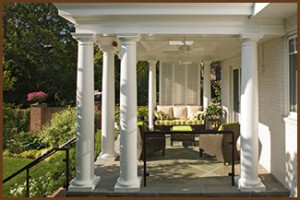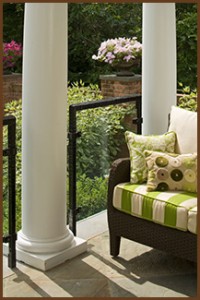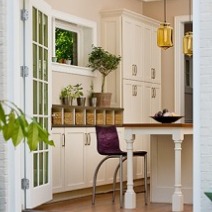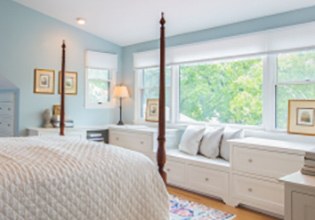Eight Columns Are Enough: Design Solutions for My Porch Addition

Tuscan columns and louvered wall panel
Several years ago, I designed and built a new rear porch for the 1923 house in Washington, DC that I own with my wife, Eryl. The new porch has become a favorite space—it’s our outdoor living room in good weather. But it was quite a process to get to the point where we could enjoy the porch.
The Old House
Our house was designed by architect Arthur B. Heaton and was among a group of five houses speculatively built in Northwest DC. It is a modest house, what could be called “Builder-Tudor-Style.” Previously owned by a couple with the U.S. State Department, the house had been rented for 15 of the 20 years they owned it and got little attention aside from a new slate roof, which I greatly appreciate. But aside from the new roof and white paint on the exterior brick, the maintenance to the house was minimal at best. A slap-dash 1967 kitchen and bath remodel was unappealing.
So when we moved into the house in 2001, we began a three-year remodeling saga: kitchen, bathrooms, windows, HVAC—you name it, it had to be done. As we got the serious remodeling work behind us and made progress with a new brick-walled garden, it was time to build our long-awaited back porch—the fun stuff.
The Porch Design Concept
The design concept was to make the porch a bit whimsical with hints of “garden folly,” which are architecturally sympathetic to the house and yet serve its purpose as a space to relax and view our brick-walled garden. To reduce maintenance and enhance my architectural vision, we agreed that it was necessary to use high-quality materials throughout, including:
- Red wood columns by Chatsworth
- A custom-made cedar wood louver panel for sun control
- Copper roofing
- Powder-coated aluminum and tempered glass railings
An existing elevated 12 x 16 foot stone terrace with steps (added in the 1967 remodel) had a brick foundation that made financial sense to keep. The elevated terrace, perfect as a garden viewing perch, received new 2-inch-thick flagstone as the floor for the new porch. It was a practical beginning for a bit of architectural indulgence.

Glass and metal railings on porch addition
The Plan
As with many aspects of life, what seemed simple at the start got complicated as the design’s floor plan emerged on paper. For example, the kitchen’s triple casement window, which provided a wonderful garden view, overlapped the existing terrace, making it impossible to place a column or pilaster at the corner where the porch met the house. And being a casement window, it had to swing out for ventilation, requiring that any column would have to be placed just so to provide space for the window to open. After many iterations and instead of solving this problem in a traditional way (with four columns, one at each corner), I decided that eight columns were needed.
Placing the columns 24 inches from the rear wall of the house looked natural and uncluttered while allowing clearance for the casement window to open. The columns were grouped in pairs to frame views at the north and south. A column was placed at each outer corner and a final pair of columns at the east elevation to frame the garden view. Each pair of columns frames the view and embraces railings at two locations, and at the south elevation, the pair of columns frames a louvered wall panel (for sun control and privacy).
An existing seven-riser brick stair allows guests to walk directly into the garden from the porch.
More about this porch design solution in the next post—stay tuned!







